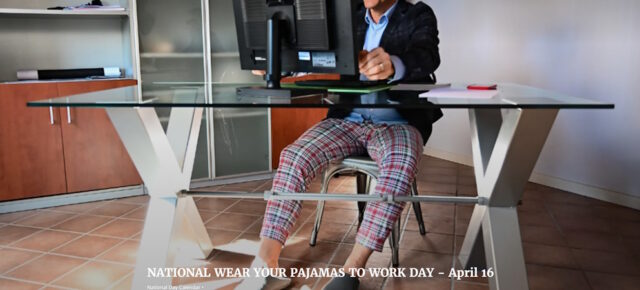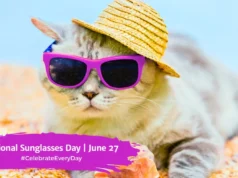
Each year on April 16th, National Wear Your Pajamas To Work Day allows us a reprieve after meeting a late-night deadline shuffling receipts and adding columns to file our taxes.
- 1700s – Pajama glamour. Masquerade ball attendees, actresses, as well as “ladies of the evening” began incorporating pajama trousers into their wardrobe, while more “respectable” women continued to look down on such fashion.
- 1800s – Derived from the Persian word meaning “leg garment,” pajamas have come a long, long way. Originating as drawstring pants traditionally worn in Southwest Asia, and introduced to the rest of the world by British colonials, PJs started to gain acceptance in the Western world by the late 1800s.
- 19th Century – Nightcaps were popular to wear to bed in the 19th century. They were intended to keep people’s heads warm but got their long pointy shape so that they were long enough to wear as a scarf, but not long enough to pose a choking hazard.
- 1911 – Pajamas went mainstream. French couturier Paul Poiret was one of the first people to create pajama outfits intended for use beyond sleeping, which was a step on their path toward widespread acceptance.
- 1920s – Beachwear. Gabrielle “Coco” Chanel made beach pajamas popular. By the end of the decade, many women wore these outfits on their summer beach vacations
- 1930s – Myrna Loy and William Powell as Nick and Nora Charles in the highly successful “Thin Man” movie series were often seen sipping martinis while dressed in fashionable sleepwear.
- 1931 – For some, the pajama had some exotic connotations associated with it and this made the garment objectionable in some people’s eyes. There was actually a pro-nightshirt campaign in 1931 which argued that “the pajama is a foreign importation that is helping to bring about the decadence of good old American institutions.”
- 1934 – The film It Happened One Night, a romantic comedy starring Claudette Colbert and Clark Gable is sometimes attributed to having started the trend toward women wanting men’s style sleeping suits. In one scene, Ms. Colbert is seen wearing a pair of pajamas borrowed from the character played by Gable.
- 1940s – During the 1940s, women began wearing “shorty” pajamas. Consisting of a smock top with frills at the hems, sleeves and leg openings, shorties were the forerunners of Baby Doll pajamas.
- Pre-1950- it was common for pajamas to have a drop seat to make it easy to use the bathroom.
- 1960s – By the 1960s, Baby Doll pajamas were quite the rage in sleepwear fashion among girls and young women.
- 1975 – Safety factor. Federal rules required children’s sleepwear up to size 14 to meet a minimal flammability standard.
- 2000s – Posh pajamas. In an era of more informal dress, designers like Ralph Lauren and Giorgio Armani brought pajama-style clothing outside of the bedroom and into daytime and evening wear.
- 2015 – According to Guinness World Records, the largest gathering of people wearing pajamas took place in Shantou, China where 1,879 people from the Guangdong Hongxing Industrial Co. wore their pajamas on October 9, 2015. One of the requirements was that they wear a one-piece pajama.
- What some people are calling “the best holiday of the year,” this day was created as a fun holiday. It is a day to celebrate and unwind from the long hours and hard work of those whose job is to prepare taxes and the anxiety of the last minute tax filers.
- When looking at the history of pajamas, there is no way to pinpoint the exact starting point. There is no patent or claim for inventing the first pajama! There are records of people in India wearing special garments to bed dating as far back as the Ottoman Empire.
- The word “pajama” comes from the Indian word “piejamah,” which described loose pants that were tied at the waist. The comfy trousers were admired by British colonials as the perfect thing to wear when napping in the afternoon, and it wasn’t long before the outfit was deemed perfect for any time spent asleep.
- Footed Pajamas Aren’t Always For Kids. They actually started out as something designed for adults. The first versions were made when people began sewing socks to the bottom of their pajama pants. It wasn’t to just keep their feet warm; it was to prevent bugs like termites from nibbling on their toes.
- While stores sell tons of pajamas these days, sleeping in your birthday suit is still popular. For example, in the UK, 47 percent of men sleep in absolutely nothing (while only 17 percent of British women go nude in the night). Americans, on the other hand, are just slightly more conservative. About 31 percent of men in the United States sleep naked and 14 percent of women go nude.
- Coco Chanel introduced lounging pajamas in the ’20s and revolutionized pajamas for women. After that, they became a totally acceptable and fashionable alternative to the traditional long nightshirt.
- Some people in Japan go out wearing something that they call a Kigurumi, which is a word used to describe what are basically pajamas that are made to look like some form of a giant stuffed animal.
Sources:












